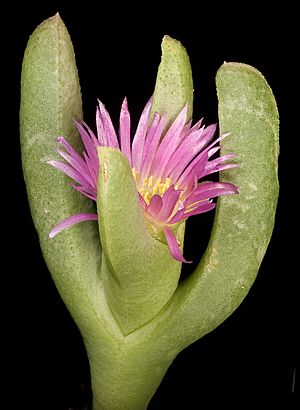Pigfaces facts for kids
Quick facts for kids Sarcozona |
|
|---|---|
 |
|
| Scientific classification | |
| Genus: |
Sarcozona
|
| Species: |
praecox
|
| Synonyms | |
|
|
Sarcozona praecox, often called sarcozona, is a special flowering plant found only in Australia. It's a type of succulent shrub, which means it has thick, fleshy parts that store water. This helps it live in dry places. The plant usually grows upright or spreads low to the ground. Its leaves are shaped like triangles and grow in pairs. When it blooms, you'll see pretty daisy-like flowers with pink "petals" and many white stamens.
Contents
What Does Sarcozona Look Like?
Sarcozona praecox is a succulent shrub that can grow about 30–50 cm (12–20 in) tall. It has smooth leaves that grow in opposite pairs on the stem. These leaves are about 40–100 mm (1.6–3.9 in) long and 4–7 mm (0.16–0.28 in) wide. They are triangular when you look at them from the side, but their edges are rounded and the top is flat.
The flowers grow one by one and are quite large, about 26–60 mm (1.0–2.4 in) wide. They either sit directly on the stem (this is called sessile) or have a very short stalk (pedicel). Two leaves are joined together at the base, partly wrapping around the flowers.
Each flower has a sepal tube, which is like a protective cup, about 10–15 mm (0.39–0.59 in) long. It usually has four small parts, or lobes, that are 3.5–10 mm (0.14–0.39 in) long. Inside the flower, there are between twenty and eighty pink, petal-like parts called staminodes. These surround 20 to 150 white stamens, which produce pollen. The flower also has four styles, which are part of the plant's reproductive system.
The ovary (where seeds develop) is about 4.5–9 mm (0.18–0.35 in) long. Unlike a similar plant, S. bicarinata, this plant's ovary does not have ribs. Sarcozona mainly flowers from August to November. After flowering, it produces a fleshy fruit called a capsule, which is about 10 mm (0.39 in) across.
How Sarcozona Got Its Name
This plant was first officially described in 1853 by a scientist named Ferdinand von Mueller. He gave it the name Mesembryathemum praecox. He wrote about it in a science journal called Linnaea: ein Journal für die Botanik in ihrem ganzen Umfange, oder Beiträge zur Pflanzenkunde. The plants he studied were collected in the Flinders Ranges in Australia.
Later, in 1965, another scientist named Stanley Thatcher Blake changed its name to Sarcozona praecox. This is the name we use today.
Where Does Sarcozona Grow?
Sarcozona grows in dry, or "arid," parts of Australia. You can find it near salt lakes, on granite rocks, and sometimes in mallee and woodland areas. It grows in western New South Wales, north-western Victoria, the south-west of Western Australia, southern South Australia, and southern Queensland.
Is Sarcozona Safe?
The Government of Western Australia's Department of Parks and Wildlife has looked at the status of this plant. They have classified Sarcozona praecox as "not threatened." This means it is not currently at risk of disappearing.


